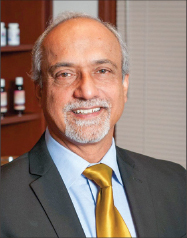Current medical advice isn’t preventing this killing disease
By Dr. Virender Sodhi


Diabetes is the sixth leading cause of death in America. It is also the country’s number one cause of blindness, non-traumatic amputations and renal failure. In this column and the next, we will discuss ways to avoid or lessen one’s chances of developing the dreaded disease through adjustments to diet and lifestyle.
Diabetes is divided into several classifications, but in general we will talk about Type 1 and Type 2 diabetes. Type 1 diabetes’ etiological factors can be genetics, autoimmune dysfunction due to gut flora imbalance, and viral diseases. It is treated with insulin, because the pancreas, which normally produces insulin, is nonfunctional. Children who are introduced to cow’s milk at less than three months of age have 1.5 times more chance of getting Type 1 diabetes than those who are breast fed. Another dietary cause of Type 1 diabetes is nitrates from water or smoked meat, which have been shown to destroy the pancreas due to oxidation. Type 1 diabetes is relatively rare, impacting less that ten percent of diabetics (statistics refer to the US, but are typical of industrialized countries).
The rest of those afflicted, 90%, have Type 2 diabetes. People with Type 2 diabetes don’t have less insulin; rather they are unable to utilize insulin. This is called insulin resistance. It can happen due to many factors, such as excessive eating of sugars or trans fatty acids, exposure to chemicals causing oxidation, and drugs such as beta-blockers given for hypertension and heart disease.
Other contributors to diabetes and many other chronic diseases are lack of essential nutrients such as chromium, a lack of essential fatty acids, such as fish oils or oils from different nuts and seeds, increased consumption of coffee or other caffeine products and increased alcohol consumption.
But obesity is single-handedly the major risk factor for diabetes. Findings from the US government’s third National Health and Nutritional Exam Survey (NHANES III) make it quite clear that diabetes is a disease of diet and lifestyle. For example, the Pima Indians live on both sides of our border with Mexico. Those in Arizona, living on a typical American diet, have a 70% rate of obesity. Twenty-two percent of the population have diabetes. Their cousins across the border, living on a more natural diet, have a rate of 10% obesity and just one percent incidence of diabetes. In 1983, only 15% of the US population met the definition of obesity. By 2000, 32% were obese. Today it is 40%. The number of obese children is increasing at an alarming rate, as is their rate of Type 2 diabetes.
According to the NHANES III study, among individuals with Type 2 diabetes, 69% did not exercise, 62% ate fewer than five servings of fruits and vegetables daily, 65% consumed more than 30% daily calories from fat and 10% of total calories from saturated fat, and 82% were either overweight or obese.
Harvard researchers studied 42,000 physicians. They divided them into two major groups according to diet. One group consisted of those with a relatively higher consumption of vegetables, fruits, fish, poultry and whole grains. The other group followed a typical Western diet, with higher consumption of red meat, processed meat, french fries, high-fat dairy products, refined grains, sweets and deserts. The Western diet alone increased the risk of Type 2 diabetes 50%. When diet was combined with low physical activity, the risk of Type 2 diabetes nearly doubled. If obesity was present, the risk jumped eleven times more!
As many as 128 million Americans are obese. Our nutritional habits are horrible, and we shun exercise. Corporate America may see this as a trillion-dollar business opportunity to cash in on, but the bottom line is we have to fix it ourselves. The government cannot stop us from eating the wrong foods and won’t arrest us for not exercising. I personally believe that the American Diabetic Association and American Medical Association have completely failed their responsibilities in preventing diabetes. We are boasting new drug treatments, but the results are not changing.
One of the most famous books mentioning the link between diet and chronic conditions such as diabetes and heart disease is Western Diseases: Their Emergence and Prevention by Denis Burkitt, MD, and Hugh Trowell, MD, first published in 1981. It was based on extensive studies examining the rate of diseases in various world populations and on observations of indigenous cultures. They formulated the following sequence of events. In the first stage, cultures consume a traditional diet consisting of whole, unprocessed foods. The rate of chronic diseases such as heart disease, diabetes and cancer is quite low. In the second stage, when cultures start eating a more Western diet, there is a sharp rise in obesity and diabetes. In the third stage, as people abandon their traditional diet, complications such as constipation, hemorrhoids, varicose veins and appendicitis become more prevalent. In the fourth stage, with the full Westernization of the diet, more chronic diseases such as heart disease, cancer, osteoarthritis, rheumatoid arthritis and gout become extremely common.
The average American consumes 100 pounds of sucrose each year. This sugar addiction probably plays a major role in the high prevalence of poor health and chronic diseases in the United States. Foods containing sugars in the form of sucrose, glucose, maltose, lactose, fructose, corn syrup or fruit juices make the body’s blood sugars go higher, and put a strain on the balance of sugar. Research in the last two decades has provided us new information on refined carbohydrates (sugars and low-fiber starchy foods) and faulty blood-glucose control. New terminologies, such as “Syndrome X” and “impaired glucose tolerance” have been used to define blood-sugar imbalance, along with lipid disorders, elevated blood sugars and inflammation. The invention of packaged food containing harmful oils, additives and substances never before consumed by humans has compounded the problem.
In the next article we discuss how to change your diet and lifestyle to lessen your chances of developing diabetes.
About the Author
Dr. Virender Sodhi holds an M.D. (Ayurveda) from India and a N.D. from Bastyr College of Naturopathic Medicine, USA. E-mail: drvsodhi@ayurvedicscience.com. Web: www.ayurvedicscience.com.


